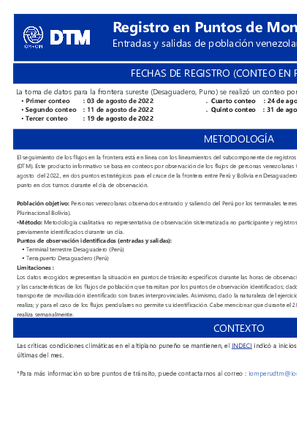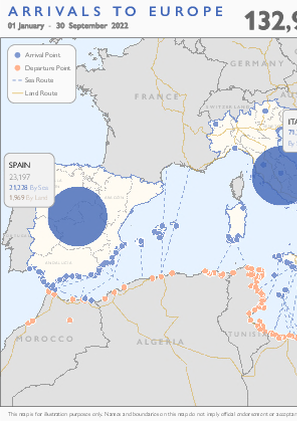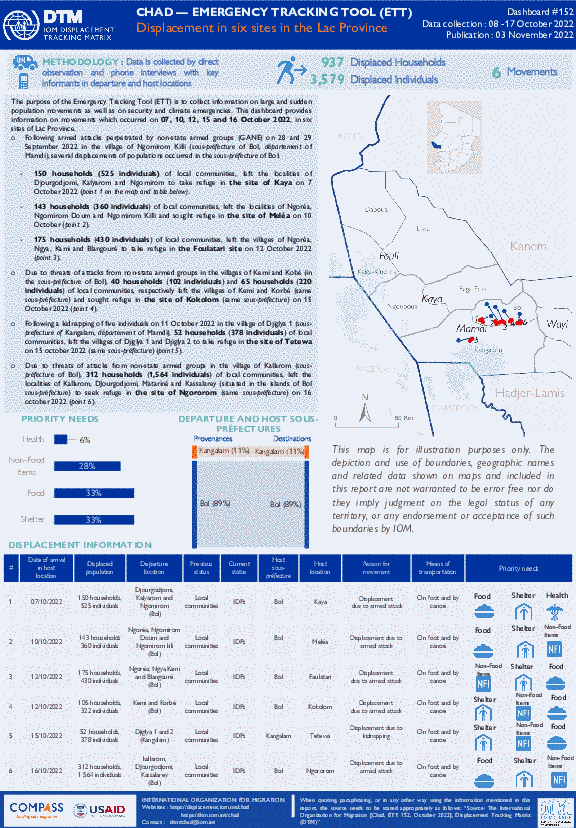-
Countries
-
Data and Analysis
-
Special Focus
-
Crisis Responses

Contact
DTM Peru, IOMDTMPeru@iom.int
Language
Spanish
Location
Peru
Period Covered
Aug 03 2022
Aug 31 2022
Activity
- Flow Monitoring
El seguimiento de los flujos en la frontera está en línea con los lineamientos del subcomponente de registros de la metodología de Matriz de Seguimiento de Desplazamiento (DTM). Este producto informativo se basa en conteos por observación de los flujos de personas venezolanas tanto de entrada como de salida, realizados el 3,11, 19, 24 y 31 de agosto del 2022, en dos puntos estratégicos para el cruce de la frontera entre Perú y Bolivia en Desaguadero. Para este conteo participaron ocho enumeradores, dos por cada punto en dos turnos durante el día de observación.

Contact
Arnin Cortez Morales arncortez@iom.int
Language
Spanish
Location
Nicaragua
Period Covered
Apr 01 2022
Jul 31 2022
Activity
- Survey
- Community Perception
- Flow Monitoring
El presente estudio tiene como objetivo general: Identificar las necesidades comunitarias en el casco urbano de Bilwi y las comunidades de Karata, Wawa Bar y Haulover enfocadas en la movilidad humana, resiliencia climática, recuperación de medios de vida, y protección sensible al género, mediante la implementación de la herramienta denominada Matriz de Seguimiento de Desplazamiento (DTM) en el contexto posterior a los huracanes Eta e Iota.
Este estudio es cuantitativo, descriptivo y exploratorio, de corte transversal debido a que se realiza en un solo período de tiempo, comprendido entre abril a julio de 2022. La metodología es una adaptación de la DTM, mediante tres instrumentos de recolección de datos: una encuesta de viviendas, encuesta de línea de base del seguimiento de la movilidad y monitoreo de flujos migratorios; y una encuesta de hogares/personas migrantes o familiares de migrantes que permitiera la elaboración de un perfil de migrantes.

Contact
Arnin Cortez Morales arncortez@iom.int
Language
Spanish
Location
Nicaragua
Period Covered
Apr 01 2022
Jun 30 2022
Activity
- Survey
- Community Perception
- Flow Monitoring
- Baseline Assessment
Se completaron un total de 38 encuestas auto aplicadas en mayo de 2022 a personas de organizaciones de la sociedad civil que actualmente laboran a través de programas o proyectos en los departamentos de Chinandega, Rivas, Nueva Segovia, Río San Juan.

Contact
DTM Peru, IOMDTMPeru@iom.int
Language
Spanish
Location
Peru
Period Covered
Aug 03 2022
Aug 31 2022
Activity
- Flow Monitoring
Los datos para este reporte fueron recolectados bajo el subcomponente de monitoreo de flujos de la metodología de la Matriz de Seguimiento de Desplazamiento (DTM). Este producto informativo se basa en conteos por observación de los flujos de población venezolana tanto de entrada como de salida, realizados el 03, 11, 19, 24 y 31 de agosto de 2022, en tres puntos en la frontera peruana con Ecuador. Se contó con 16 enumeradores, dos por cada punto en dos turnos durante el día de observación.
Europe First Arrivals Map - January-September 2022
Europe Migrant Presence Overview Map - as of end of September 2022

Contact
DTMUkraine@iom.int
Language
English
Location
Ukraine
Period Covered
Oct 17 2022
Oct 27 2022
Activity
- Survey
Between 17 and 27 October the International Organization for Migration (IOM) conducted the tenth round of a rapid representative assessment of the general population in Ukraine to gather insights into internal displacement and mobility flows, and to assess local needs. This general population survey serves as a preliminary source to identify areas with high humanitarian needs and to inform the targeting of response aiming to assist the war affected population. The geographical scope of the assessment covers the entire territory of Ukraine, all five macro regions (East, North, Centre, South, and the city of Kyiv), with the exception of the Crimean peninsula. The general population survey was constructed through a random digit dial (RDD) approach, and 2,002 unique and anonymous respondents aged 18 and over were interviewed using the computer assisted telephone interview (CATI) method. The estimates rely on the UNFPA population data for Ukraine, agreed upon as the common population baseline by the humanitarian community. Those currently outside Ukraine were not interviewed. For further notes on method and limitations, including IOM’s definition of internally displaced persons used for the purpose of this assessment, see page 12 In addition to this General Population Survey, data on recorded IDP presence at hromada level in Ukraine are available from IOM’s Displacement Tracking Matrix Baseline Assessment (Round 14, October 16, 2022, HDX, registration required).

Contact
DTM Zimbabwe, DTMzimbabwe@iom.int, DTMsupport@iom.int
Language
English
Location
Zimbabwe
Period Covered
Sep 01 2022
Sep 30 2022
Activity
- Flow Monitoring
During the month of September 2022, a total of 47,210 movements were recorded and 3,251 migrants were interviewed across 43 Flow Monitoring Points (FMPs) in Zimbabwe. The total movements recorded increased by 11% compared to the previous month. 58% of movements observed were inflows, whilst 42% were outflows. The top three sending districts were Beitbridge (39%), Harare (11%), and Masvingo (10%) and the top receiving districts were Beitbridge (21%), Harare (21%) and Hurungwe (7%).
South Africa-Zimbabwe corridor recorded the highest movement of 37,710 (80%) followed by Zambia-Zimbabwe corridor which recorded 5,139(11%) movements. Out of the 19,959 outflows observed, 77% of were recorded along irregular crossing points compared to 38% of inflows. Most migrants chose to use formal crossing points when entering the country. The cited reasons for using informal crossing points were lack of travelling documents, proximity to intended destination and proximity to service centres such as clinics and workplaces. Migrants prefer using the formal entry points when returning to the country since there are no restrictions when returning to the country of origin and also due to the high security risks encountered when using informal crossing points. An increase in the number of outgoing migrants can be attributed to the return of migrants to their livelihood activities following the August holidays. Beitbridge Border Post, Dite and Chituripasi were the preferred exit points accounting for 34% of outflows whilst Beitbridge border post was the preferred entry point recording 46% of inflows followed by Maroyi (5%) and Chirundu border post (5%).

Contact
DTM Cameroon, DTMCameroun@iom.int
Language
French
Location
Cameroon
Period Covered
Nov 02 2022
Nov 03 2022
Activity
- Mobility Tracking
- Event Tracking
Le suivi des situations d’urgence (en anglais, Emergency Tracking Tool, ETT) est une des composantes de la Matrice de suivi des déplacements (DTM) déployée par l’Organisation Internationale pour les Migrations (OIM). Il a pour objectif de rassembler des informations sur les mouvements significatifs et soudains de populations ainsi que sur des urgences sécuritaires et climatiques. Les données ont été collectées par observation directe et par des entretiens téléphoniques, auprès de 05 informateurs clés, principalement les autorités locales, les organisations non gouvernementales (ONGs), les organisations de la société civile (OSCs) et les représentants des populations sinistrées dans les lieux affectés. Ce tableau de bord présente les informations sur les personnes affectées par la montée des eaux du fleuve Logone ayant provoqué des inondations et plusieurs dégâts matériels.
Depuis le mois octobre 2022 jusqu’à nos jours, les localités situées sur les berges du fleuve Logone du côté de la République du Tchad ont été victimes de la montée des eaux (inondations) qui ont provoqué le déplacement de plus d’une centaine de personnes de la localité de Gamal au Tchad vers la localité de Logone Birni centre (Quartier Tikini)
dans l’arrondissement du Logone Birni, département du Logone et Chari, dans la région de l’Extrême-Nord du Cameroun.

Contact
DTM Zimbabwe, DTMzimbabwe@iom.int
Language
English
Location
Zimbabwe
Period Covered
Aug 01 2022
Aug 31 2022
Activity
- Flow Monitoring
During the month of August 2022, a total of 42,489 movements were recorded. 3,057 migrants were interviewed across 44 Flow Monitoring Points (FMPs) in Zimbabwe. The total movements recorded decreased by 4% compared to the previous month, in which 44,380 were observed. 57% of movements observed were inflows, whilst 43% were outflows. The top three sending districts were Bulawayo (17%), Beitbridge (11%), and Harare and the top three receiving districts were Harare (18%), Karoi (13%) and Mutare (8%).
South Africa-Zimbabwe corridor recorded 33,123 (78%) while the Zambia-Zimbabwe corridor recorded 4,784 (11%) movements. 79% of outflows were recorded along irregular crossing points compared to 45% of inflows. Most migrants chose to use formal crossing points when entering the country. Chituripasi, Dite and the Beitbridge main border accounted for 33% of outflows and were the preferred exit points out of Zimbabwe by migrants. Beitbridge border post recorded 44% of inflows and was the preferred entry point by migrants followed by Maroyi (6%) and Tshabili (6%) along the South Africa. Of the surveyed migrants 56% were males. Movements along the Zambia-Zimbabwe corridor recorded the highest number of female migrants, 63% compared to 37% of males. The South Africa-Zimbabwe corridor recorded the highest number of male migrants (61%) of the total surveyed. Most of the surveyed migrants indicated that they were travelling to conduct commercial activities.

